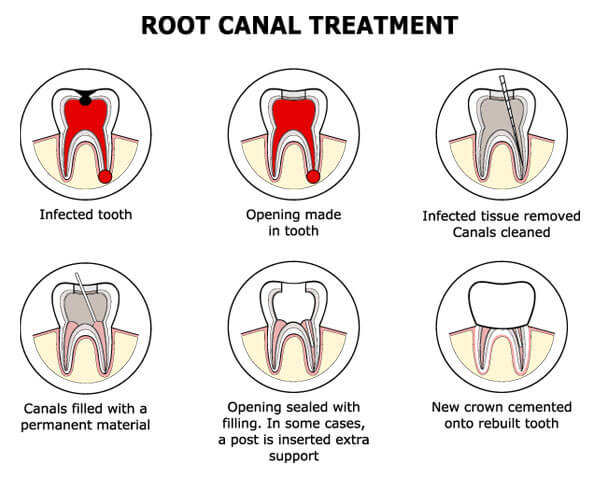
Whittier Dental Arts
The Art of dentistry in Whittier
Root Canals in Whittier, CA
When a tooth is experiencing pain or discomfort, many times the only solution to relieving these symptoms is a root canal by Dr. Alan Gutierrez at Whittier Dental Arts.
When decay or damage to a tooth has reached to the pulp or fibrous tissue within the tooth, a tooth becomes diseased and open to bacterial infection. In order to save your natural tooth, root canal therapy is required.
This involves removing the damaged enamel and the diseased pulp, then refilling the space and capping it with a porcelain or ceramic crown to restore the strength and stability of the tooth. Once your procedure is completed you will have the full use of your tooth again and relief from any pain.
Because the comfort of his patients is always of first concern in Whittier Dental Arts, Dr. Gutierrez utilizes only the latest in advanced dentistry techniques and equipment that will help to make this procedure quick, effective and as comfortable as possible.
When decay or damage to a tooth has reached to the pulp or fibrous tissue within the tooth, a tooth becomes diseased and open to bacterial infection. In order to save your natural tooth, root canal therapy is required.
This involves removing the damaged enamel and the diseased pulp, then refilling the space and capping it with a porcelain or ceramic crown to restore the strength and stability of the tooth. Once your procedure is completed you will have the full use of your tooth again and relief from any pain.
Because the comfort of his patients is always of first concern in Whittier Dental Arts, Dr. Gutierrez utilizes only the latest in advanced dentistry techniques and equipment that will help to make this procedure quick, effective and as comfortable as possible.
Why Does Tooth Pulp Need to Be Removed?
When a tooth’s nerve tissue or pulp is damaged, it breaks down and bacteria begin to multiply within the pulp chamber. The bacteria and other decayed debris can cause an infection or abscessed tooth. An abscess is a pus-filled pocket that forms at the end of the roots of the tooth. An abscess occurs when the infection spreads all the way past the ends of the roots of the tooth. In addition to an abscess, an infection in the root canal of a tooth can cause:
- Swelling that may spread to other areas of the face, neck, or head
- Bone loss around the tip of the root
- Drainage problems extending outward from the root. A hole can occur through the side of the tooth with drainage into the gums or through the cheek with drainage into the skin.
What are the Signs That a Root Canal is Needed?
Sometimes no symptoms are present; however, signs you may need a root canal include:
- Severe toothache pain upon chewing or application of pressure
- Prolonged sensitivity/pain to heat or cold temperatures (after the hot or cold has been removed)
- Discoloration (a darkening) of the tooth
- Swelling and tenderness in nearby gums
- A persistent or recurring pimple in the gums
The Root Canal Treatment

The root canal treatment consists of the removal of the infected or irritated nerve tissue that lies within the root of the tooth. It is this infected pulp tissue that causes an eventual abscess.
The first step in a root canal is to obtain access to the nerve. This is accomplished by establishing a small access opening in the top of the tooth. It will be done under a local anesthetic. The length of the root canals is determined and the infected pulp is removed.
At the same visit, the canal where the nerve is located will be reshaped and prepared to accept a special root canal filling material. This filling procedure will probably not occur until your next visit. The number of visits necessary to complete your root canal will depend upon several factors including the number of nerves in the tooth, the infected state of the nerve and the complexity of the procedure.
The final step in your Root Canal Treatment will be the sealing of the root canal with a sterile, plastic material, called gutta percha. This is done in order to prevent possible future infection.
The tooth will then possibly need a post and core and a crown in order to re-establish normal form and function. This decision will be based upon several additional factors.
If treated early, root canal therapy need not be uncomfortable. With the use of local anesthetics, the entire procedure can be totally painless.
Another mistaken belief is that by removing the nerve the tooth becomes “dead “. This is not true. The tooth is very much alive and functioning because it receives a source of blood supply and nerve supply from the surrounding tissues that hold it in place in your jaw bone. The tooth will have no sense of feeling to hot, cold or sweets but will be responsive to biting pressures etc. With the proper restoration the tooth should last as long as your other teeth and can even be used as an anchor tooth for a partial denture or cemented bridge. The success rates for root canal therapy have been reported to be as high as 95%.
Sometimes when there has been long standing infection or abscess, there may be some soreness associated with the first or second root canal visit. If this should turn out to be true you will be given specific instructions to follow to minimize the discomfort. When an infection is present, it may be necessary to take an antibiotic. If pain should be present, analgesics may need to be prescribed. In either case, be sure to call your dental office if either of these problems should arise.
The first step in a root canal is to obtain access to the nerve. This is accomplished by establishing a small access opening in the top of the tooth. It will be done under a local anesthetic. The length of the root canals is determined and the infected pulp is removed.
At the same visit, the canal where the nerve is located will be reshaped and prepared to accept a special root canal filling material. This filling procedure will probably not occur until your next visit. The number of visits necessary to complete your root canal will depend upon several factors including the number of nerves in the tooth, the infected state of the nerve and the complexity of the procedure.
The final step in your Root Canal Treatment will be the sealing of the root canal with a sterile, plastic material, called gutta percha. This is done in order to prevent possible future infection.
The tooth will then possibly need a post and core and a crown in order to re-establish normal form and function. This decision will be based upon several additional factors.
If treated early, root canal therapy need not be uncomfortable. With the use of local anesthetics, the entire procedure can be totally painless.
Another mistaken belief is that by removing the nerve the tooth becomes “dead “. This is not true. The tooth is very much alive and functioning because it receives a source of blood supply and nerve supply from the surrounding tissues that hold it in place in your jaw bone. The tooth will have no sense of feeling to hot, cold or sweets but will be responsive to biting pressures etc. With the proper restoration the tooth should last as long as your other teeth and can even be used as an anchor tooth for a partial denture or cemented bridge. The success rates for root canal therapy have been reported to be as high as 95%.
Sometimes when there has been long standing infection or abscess, there may be some soreness associated with the first or second root canal visit. If this should turn out to be true you will be given specific instructions to follow to minimize the discomfort. When an infection is present, it may be necessary to take an antibiotic. If pain should be present, analgesics may need to be prescribed. In either case, be sure to call your dental office if either of these problems should arise.
Post-Operative Instructions for Root Canal Treatment
- Postoperative discomfort is sometimes experienced after a treatment visit. This is due to irritation of the bone surrounding the tooth and may range from a mild discomfort in the area to an occasional episode of considerable pain. This discomfort will usually maximize in approximately 48-72 hours and then subside. Please avoid chewing on the treated tooth for a few days.
- If a throbbing sensation occurs please keep your head elevated as much as possible and place extra pillows under your head when lying down. Avoid as much as possible any strenuous activity as well.
- If your tooth has been left open to aid in drainage of an infection, please place cotton in your tooth as directed. Do not leave the cotton in the tooth between meals.
- If swelling of the gum is present or should appear after a treatment visit, please rinse the area every 1-2 hours with a solution of warm salt water prepared by adding a teaspoon of salt to an 8 oz. Glass of warm water.
- If swelling of the face is present or should appear, apply an ice pack to the area for 5 minutes every ½ hour.
- If antibiotic medication has been prescribed please take it as indicated until you have finished ALL of the medication. If you encounter any difficulty in breathing or a skin rash, or gastric disturbance should occur, please discontinue the medication and call the office.
- If medication for pain has been prescribed, please take it as indicated. It is important to bear in mind that narcotic medications such as Codeine, Vicodin, Percodan and Demerol may make you drowsy. Therefore, caution should be exercised in operating any potentially dangerous machinery or an automobile.
After your procedure, your tooth’s roots will be clean, strong, and healthy, just like the rest of your mouth, with no sign of disease. This can give you one more reason to smile, and that’s all we want from those who visit Whittier Dental Arts.
VISIT WHITTIER DENTAL ARTS
-
 Root Canals
Root Canals
-
 Periodontics
Periodontics
-
 Minimally Invasive Dentistry
Minimally Invasive Dentistry
-
 Air Abrasion
Air Abrasion
RELATED
Hours
Mon
9am – 6pm
Tue
9am – 6pm
Wed
9am – 6pm
Thu
9am – 6pm
Fri
9am – 6pm
Sat
8am – 2pm
By appointment only


5.0 Rating
Start Your Journey Today
(562) 907-6000
Call or complete this form
- General Inquiry
- Request Appointment
[ninja_form id=2]
[ninja_form id=3]